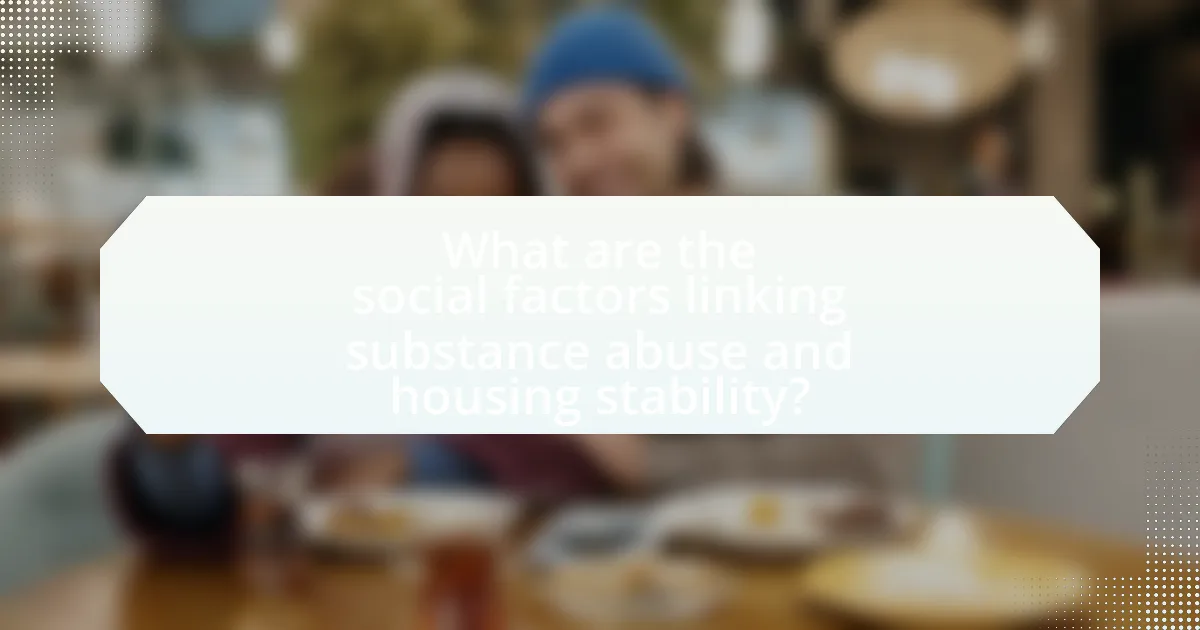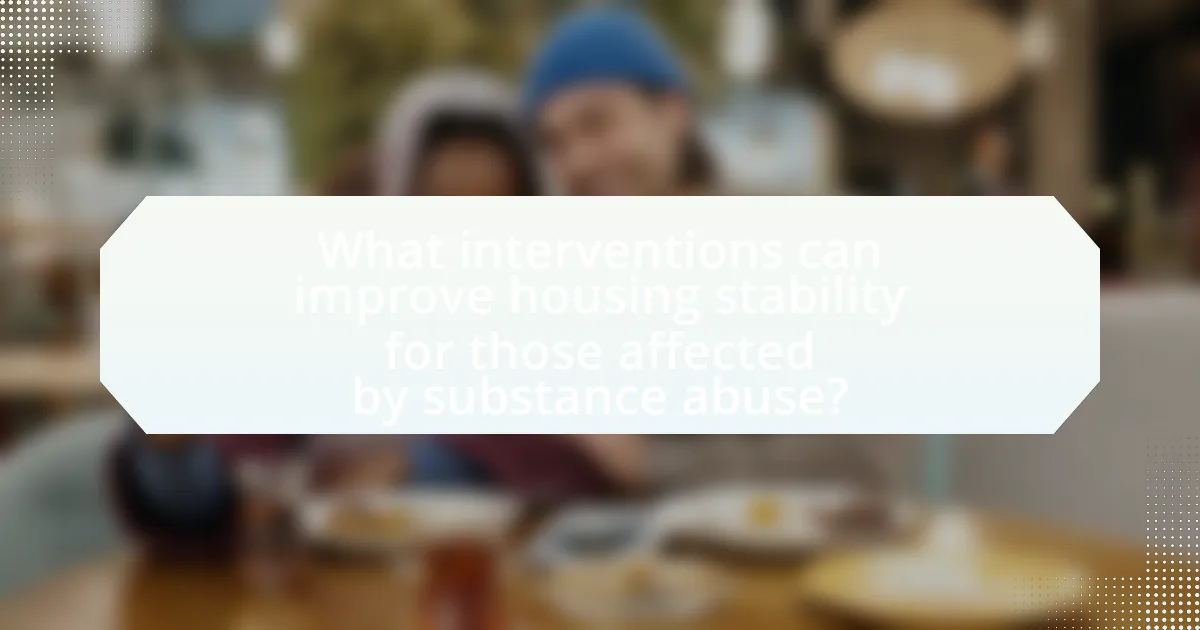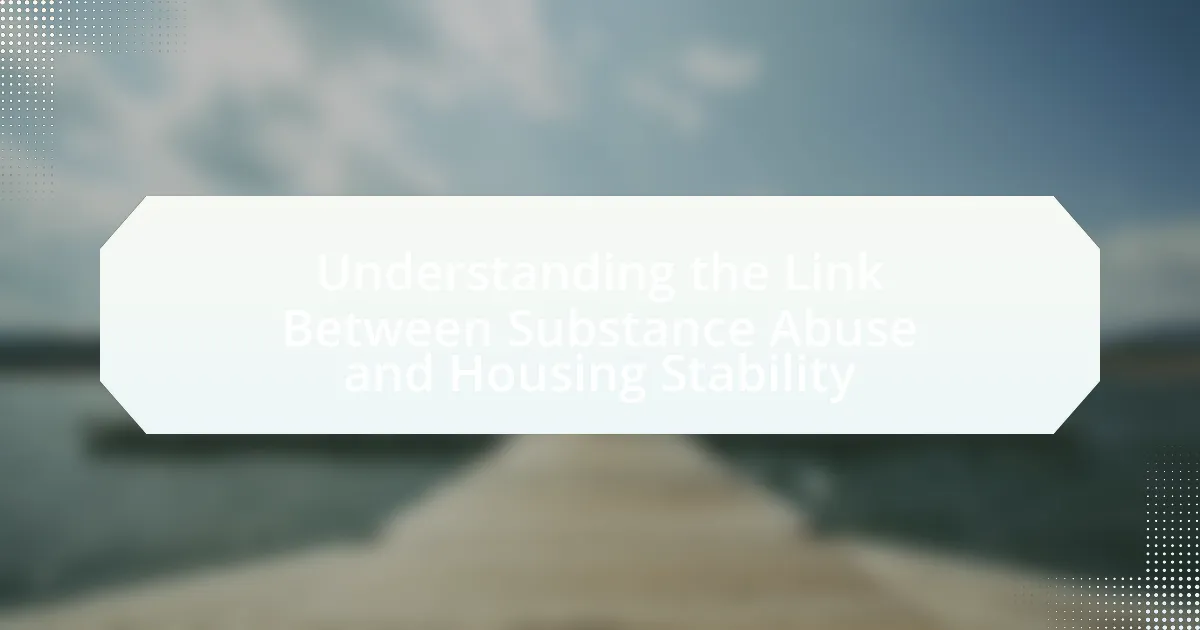The article examines the critical relationship between substance abuse and housing stability, highlighting how substance use disorders contribute to homelessness and housing insecurity. It discusses the financial, psychological, and social factors that impair an individual’s ability to maintain stable housing, including job loss, strained relationships, and mental health challenges. The article also emphasizes the importance of stable housing in supporting recovery from substance abuse, detailing effective interventions such as housing-first models and integrated service delivery approaches. Additionally, it addresses the role of community resources and policy changes in improving housing stability for individuals affected by substance abuse, ultimately underscoring the interconnectedness of these issues.

What is the relationship between substance abuse and housing stability?
Substance abuse negatively impacts housing stability by increasing the likelihood of homelessness and housing insecurity. Individuals struggling with substance use disorders often face challenges such as job loss, financial instability, and strained relationships, which can lead to eviction or inability to maintain stable housing. Research indicates that approximately 30% of homeless individuals have a substance use disorder, highlighting the direct correlation between substance abuse and the risk of losing stable housing. Furthermore, unstable housing can exacerbate substance abuse issues, creating a cyclical relationship where lack of housing contributes to continued substance use and vice versa.
How does substance abuse impact an individual’s ability to maintain stable housing?
Substance abuse significantly impairs an individual’s ability to maintain stable housing by leading to financial instability, social isolation, and deteriorating mental and physical health. Financially, individuals may prioritize spending on substances over rent or mortgage payments, resulting in eviction or foreclosure. Research indicates that approximately 30% of homeless individuals have a substance use disorder, highlighting the correlation between addiction and housing instability. Additionally, substance abuse can strain relationships with family and friends, reducing social support networks that are crucial for securing and maintaining housing. Furthermore, the health consequences of substance abuse can limit employment opportunities, further exacerbating financial difficulties and increasing the risk of homelessness.
What are the psychological effects of substance abuse that influence housing stability?
Substance abuse leads to several psychological effects that significantly influence housing stability, including increased anxiety, depression, and impaired decision-making. These psychological conditions can result in unstable employment, strained relationships, and difficulty managing finances, all of which are critical for maintaining stable housing. For instance, a study published in the Journal of Substance Abuse Treatment found that individuals with substance use disorders are more likely to experience homelessness due to these psychological challenges, highlighting the direct correlation between mental health issues stemming from substance abuse and the risk of losing housing stability.
How does financial instability due to substance abuse affect housing security?
Financial instability caused by substance abuse significantly undermines housing security. Individuals struggling with substance abuse often face job loss, reduced income, and increased medical expenses, leading to an inability to afford housing costs. According to the National Institute on Drug Abuse, approximately 20% of individuals with substance use disorders experience homelessness at some point in their lives, highlighting the direct correlation between financial instability and housing insecurity. This instability can result in eviction, increased reliance on temporary housing solutions, and a higher likelihood of living in unsafe or unstable environments.
Why is housing stability important for individuals struggling with substance abuse?
Housing stability is crucial for individuals struggling with substance abuse because it provides a secure environment that supports recovery efforts. Stable housing reduces stress and instability, which are significant triggers for substance use. Research indicates that individuals with stable housing are more likely to engage in treatment programs and maintain sobriety. For instance, a study published in the American Journal of Public Health found that stable housing significantly improved treatment outcomes for individuals with substance use disorders, highlighting the direct correlation between housing security and recovery success.
What role does stable housing play in recovery from substance abuse?
Stable housing is crucial for recovery from substance abuse as it provides a safe and supportive environment that fosters stability and reduces stressors associated with homelessness or unstable living conditions. Research indicates that individuals with stable housing are more likely to engage in treatment programs, adhere to recovery plans, and maintain sobriety. For instance, a study published in the American Journal of Public Health found that stable housing significantly decreases the likelihood of relapse among individuals recovering from substance use disorders. This correlation highlights the importance of housing stability as a foundational element in the recovery process.
How does housing instability exacerbate substance abuse issues?
Housing instability significantly exacerbates substance abuse issues by creating chronic stress and uncertainty, which can lead individuals to seek relief through drugs or alcohol. Research indicates that individuals experiencing housing instability often face increased mental health challenges, such as anxiety and depression, which are closely linked to higher rates of substance use. For instance, a study published in the American Journal of Public Health found that individuals who are homeless or at risk of homelessness are more likely to engage in substance use as a coping mechanism for their unstable living conditions. Furthermore, the lack of a stable home environment can hinder access to treatment and support services, perpetuating a cycle of addiction and instability.

What are the social factors linking substance abuse and housing stability?
Social factors linking substance abuse and housing stability include economic hardship, social isolation, and lack of access to support services. Economic hardship often leads individuals to substance use as a coping mechanism, while unstable housing can exacerbate feelings of isolation, making it difficult to seek help. Additionally, individuals without stable housing may lack access to essential services such as healthcare and counseling, which are critical for addressing both substance abuse and housing issues. Research indicates that individuals experiencing homelessness are significantly more likely to struggle with substance use disorders, highlighting the interconnectedness of these social factors.
How do community resources impact the relationship between substance abuse and housing stability?
Community resources significantly influence the relationship between substance abuse and housing stability by providing essential support systems that address both issues concurrently. Access to services such as counseling, rehabilitation programs, and housing assistance can reduce the likelihood of substance abuse relapse and promote stable living conditions. For instance, a study published in the Journal of Substance Abuse Treatment found that individuals who participated in integrated housing and substance abuse treatment programs experienced a 50% reduction in substance use and improved housing stability compared to those who did not have access to such resources. This evidence underscores the critical role that community resources play in mitigating the adverse effects of substance abuse on housing stability.
What types of community support systems are effective in addressing this link?
Effective community support systems that address the link between substance abuse and housing stability include integrated service models, peer support networks, and housing-first initiatives. Integrated service models combine substance abuse treatment with mental health services and housing assistance, facilitating comprehensive care that addresses multiple needs simultaneously. Peer support networks leverage the experiences of individuals in recovery to provide guidance and encouragement, fostering a sense of community and belonging. Housing-first initiatives prioritize providing stable housing without preconditions, which has been shown to significantly reduce substance use and improve overall well-being, as evidenced by studies indicating that stable housing leads to better treatment outcomes and lower rates of homelessness among individuals with substance use disorders.
How does social stigma surrounding substance abuse affect housing opportunities?
Social stigma surrounding substance abuse significantly limits housing opportunities for individuals affected by addiction. This stigma often leads to discrimination from landlords and housing providers, who may perceive individuals with a history of substance abuse as unreliable tenants. Research indicates that approximately 50% of landlords are unwilling to rent to individuals with a history of substance use disorders, as highlighted in a study published by the National Institute on Drug Abuse. Consequently, this discrimination exacerbates homelessness and housing instability among those struggling with addiction, making it difficult for them to secure stable living conditions necessary for recovery and reintegration into society.
What demographic factors contribute to the link between substance abuse and housing stability?
Demographic factors such as age, gender, socioeconomic status, and race significantly contribute to the link between substance abuse and housing stability. Younger individuals, particularly those aged 18-25, are more likely to experience substance abuse issues, which can lead to unstable housing situations. Gender differences also play a role, as men generally have higher rates of substance abuse compared to women, impacting their housing stability. Socioeconomic status is critical; individuals with lower income levels often face housing instability, which can exacerbate substance abuse problems. Additionally, racial and ethnic minorities may experience systemic barriers that increase both substance abuse rates and housing instability, as evidenced by studies showing higher rates of homelessness and substance use disorders in these populations.
How do age, gender, and socioeconomic status influence this relationship?
Age, gender, and socioeconomic status significantly influence the relationship between substance abuse and housing stability. Younger individuals often face higher rates of substance abuse due to factors like peer pressure and lack of coping mechanisms, while older adults may experience substance abuse as a means of coping with life stressors, impacting their housing stability. Gender differences reveal that men are generally more likely to engage in substance abuse, which can lead to unstable housing situations, while women may face unique challenges such as trauma and caregiving responsibilities that affect their substance use and housing security. Socioeconomic status plays a critical role, as individuals from lower socioeconomic backgrounds often experience higher rates of substance abuse due to stressors like poverty and lack of access to resources, which in turn can lead to increased housing instability. Research indicates that individuals with lower socioeconomic status are more likely to experience both substance abuse and housing instability, creating a cyclical relationship that exacerbates their challenges.
What specific populations are most at risk for housing instability due to substance abuse?
Individuals experiencing housing instability due to substance abuse include those with mental health disorders, low-income families, homeless individuals, and veterans. Research indicates that individuals with co-occurring mental health and substance use disorders face higher risks of eviction and homelessness, as they often lack access to stable housing and support services. Additionally, low-income families are particularly vulnerable, as financial strain can exacerbate substance use issues, leading to further instability. Homeless individuals frequently struggle with substance abuse, which complicates their ability to secure housing. Veterans, especially those with PTSD or other service-related mental health issues, also face significant risks of housing instability linked to substance abuse.

What interventions can improve housing stability for those affected by substance abuse?
Housing-first interventions can significantly improve housing stability for individuals affected by substance abuse. This approach prioritizes providing stable housing without preconditions, allowing individuals to address their substance use issues in a supportive environment. Research indicates that housing-first models lead to higher rates of housing retention, with studies showing that 80-90% of participants maintain their housing after one year. Additionally, integrating supportive services such as case management, mental health care, and substance use treatment further enhances the effectiveness of these interventions, as evidenced by the success rates reported in programs like the Pathways Housing First model.
How can housing-first approaches benefit individuals with substance abuse issues?
Housing-first approaches benefit individuals with substance abuse issues by providing stable housing as a primary intervention, which significantly improves their overall well-being and recovery outcomes. Research indicates that when individuals experiencing homelessness are provided with immediate access to permanent housing, they are more likely to engage in treatment for substance abuse, reduce their substance use, and experience fewer health issues. For instance, a study published in the American Journal of Public Health found that participants in housing-first programs had a 50% reduction in substance use and a 60% increase in housing stability compared to those who did not receive housing-first support. This model emphasizes that stable housing creates a foundation for individuals to address their substance use issues more effectively, leading to long-term recovery and improved quality of life.
What are the key components of effective housing-first programs?
Effective housing-first programs primarily consist of immediate access to permanent housing, supportive services, and a focus on individual choice. Immediate access to permanent housing eliminates barriers such as sobriety requirements, allowing individuals to secure stable living conditions quickly. Supportive services, including case management, mental health care, and substance abuse treatment, are essential for addressing the diverse needs of residents. Additionally, emphasizing individual choice empowers participants to make decisions about their housing and support, fostering a sense of autonomy and engagement in their recovery process. Research indicates that these components significantly improve housing stability and reduce substance abuse among participants, demonstrating the effectiveness of the housing-first approach in addressing homelessness and related issues.
How do these programs address the needs of individuals struggling with addiction?
These programs address the needs of individuals struggling with addiction by providing comprehensive support that includes access to treatment, counseling, and stable housing. Research indicates that stable housing significantly improves recovery outcomes, as individuals with secure living conditions are more likely to engage in treatment and maintain sobriety. For example, a study published in the American Journal of Public Health found that participants in housing-first programs experienced reduced substance use and improved mental health. By integrating housing assistance with addiction treatment, these programs create a supportive environment that fosters recovery and stability.
What role do policy changes play in supporting housing stability for those with substance abuse problems?
Policy changes play a crucial role in supporting housing stability for individuals with substance abuse problems by creating frameworks that facilitate access to affordable housing and integrated support services. These changes can include the implementation of housing-first models, which prioritize providing stable housing without preconditions, thereby reducing barriers for those struggling with addiction. For instance, studies have shown that programs like the Housing First initiative have led to significant reductions in homelessness and improved health outcomes for participants, demonstrating the effectiveness of policy interventions in this area. Additionally, policies that promote collaboration between housing agencies and substance abuse treatment providers can enhance the availability of comprehensive support, further stabilizing housing situations for affected individuals.
What policies have been successful in linking housing support with substance abuse treatment?
Policies that have been successful in linking housing support with substance abuse treatment include the Housing First model and integrated service delivery approaches. The Housing First model prioritizes providing stable housing without preconditions, which has been shown to improve housing stability and reduce substance use among participants. For example, a study published in the American Journal of Public Health found that individuals in Housing First programs had significantly lower rates of substance use and improved mental health outcomes compared to those in traditional treatment settings. Integrated service delivery approaches, which combine housing assistance with substance abuse treatment and mental health services, have also demonstrated effectiveness. Research from the Substance Abuse and Mental Health Services Administration indicates that these comprehensive strategies lead to better retention in treatment and improved overall health outcomes for individuals facing both housing instability and substance use disorders.
How can advocacy efforts improve access to stable housing for affected individuals?
Advocacy efforts can improve access to stable housing for affected individuals by influencing policy changes, increasing funding for housing programs, and raising public awareness about the importance of stable housing in recovery from substance abuse. For instance, advocacy groups can lobby for legislation that prioritizes affordable housing initiatives, which can lead to increased availability of resources for individuals facing housing instability. Research indicates that stable housing significantly reduces the likelihood of relapse in individuals recovering from substance abuse, highlighting the critical role of housing in the recovery process. Furthermore, advocacy can mobilize community support and resources, creating a network that assists individuals in securing and maintaining stable housing, thereby enhancing their overall well-being and recovery outcomes.
What practical steps can individuals take to secure housing stability while addressing substance abuse?
Individuals can secure housing stability while addressing substance abuse by engaging in comprehensive treatment programs and accessing supportive housing services. Comprehensive treatment programs, such as those that combine behavioral therapy with medication-assisted treatment, have been shown to improve recovery outcomes and enhance housing stability. For instance, the Substance Abuse and Mental Health Services Administration (SAMHSA) reports that individuals who participate in such programs are more likely to maintain stable housing compared to those who do not.
Additionally, accessing supportive housing services, which provide not only shelter but also case management and recovery support, can significantly reduce the risk of homelessness. Research indicates that supportive housing interventions lead to a 70% reduction in homelessness among individuals with substance use disorders. By actively participating in these programs and utilizing available resources, individuals can effectively address their substance abuse issues while securing stable housing.

Leave a Reply